Do Cowbirds Kick Cardinals Out of Their Nests?
Cowbirds don't physically kick cardinals out of their nests but their brood parasitism can be devastating for cardinal offspring. Female cowbirds lay their eggs in cardinal nests, forcing cardinals to incubate and care for the cowbird chicks.
These cowbird eggs hatch earlier and the chicks grow faster, monopolizing food and resources. This leads to higher mortality rates for the cardinal chicks due to malnutrition and competition.
While cardinals are attentive parents, they often can't distinguish cowbird eggs from their own, resulting in misallocated care. To grasp the full ecological impact of this behavior, there's much more to uncover.
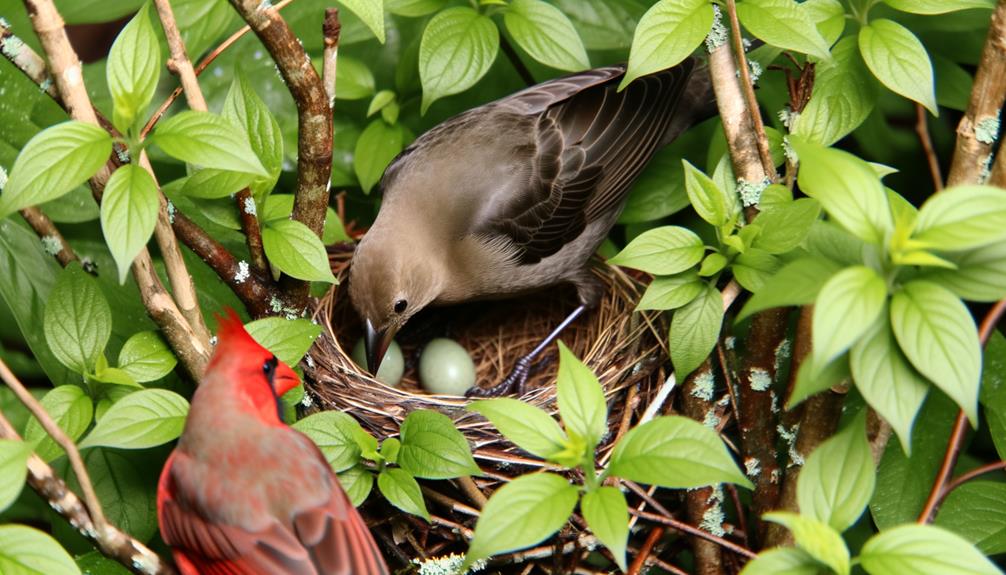
Key Takeaways
- Cowbirds do not physically kick cardinals out of their nests.
- Cowbird chicks outcompete cardinal chicks for resources, leading to higher mortality in cardinal offspring.
- Cardinals often inadvertently neglect their own eggs due to the presence of cowbird eggs.
- Cowbird eggs hatch earlier, giving cowbird chicks a developmental advantage over cardinal chicks.
- Cowbirds lay their eggs in cardinal nests to exploit the cardinals' parental care.
Understanding Brood Parasitism
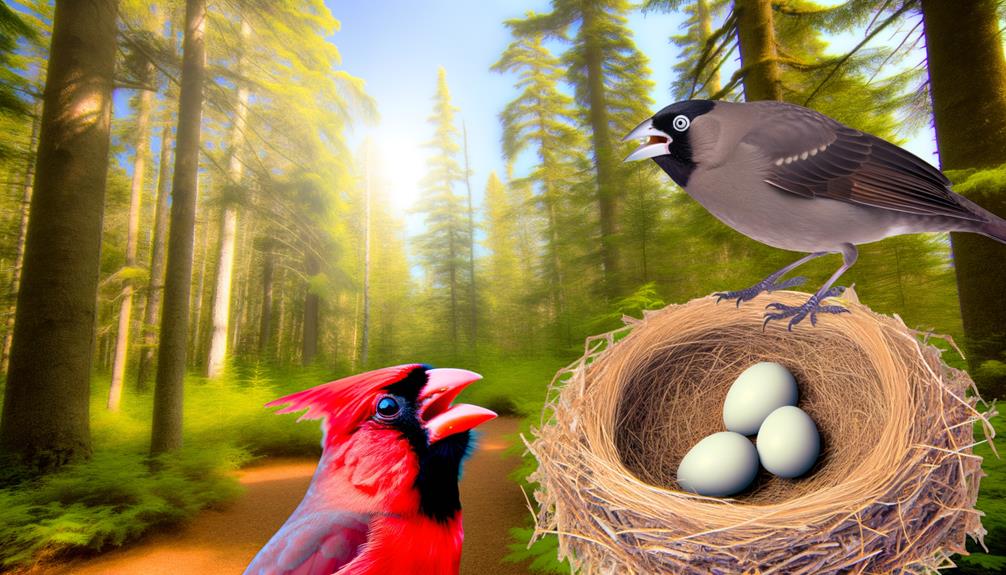
Brood parasitism, where birds like cowbirds lay their eggs in the nests of other species, disrupts the reproductive success of host birds such as cardinals.
You'll notice that cowbirds don't build their own nests. Instead, they rely on species like cardinals to incubate and raise their young.
This parasitic behavior often leads to the host birds inadvertently neglecting their own eggs.
Studies show that cowbird chicks typically hatch earlier and grow faster, monopolizing the food and care provided by the host parents.
As a result, cardinal chicks face higher mortality rates.
By observing these interactions, you'll see a clear impact on the host species' population dynamics and overall fitness.
Understanding these dynamics is essential for grasping the broader ecological implications.
Who Are Cowbirds?
Cowbirds, members of the family Icteridae, are notorious for their parasitic reproductive strategy, which has significant ecological ramifications.
You'll find that cowbirds, especially the Brown-headed Cowbirds (Molothrus ater), don't build their own nests. Instead, they lay their eggs in the nests of other bird species. This behavior, known as brood parasitism, forces the host bird to raise cowbird chicks, often at the expense of their offspring.
Evidence shows cowbird eggs hatch sooner, and their chicks grow faster, outcompeting the host's young for food. It's fascinating but disruptive; cowbirds have adapted to exploit this niche, impacting bird populations and community dynamics.
You might admire their strategy or find it troubling, but it's undeniably effective for their survival.
Cardinal Nesting Habits
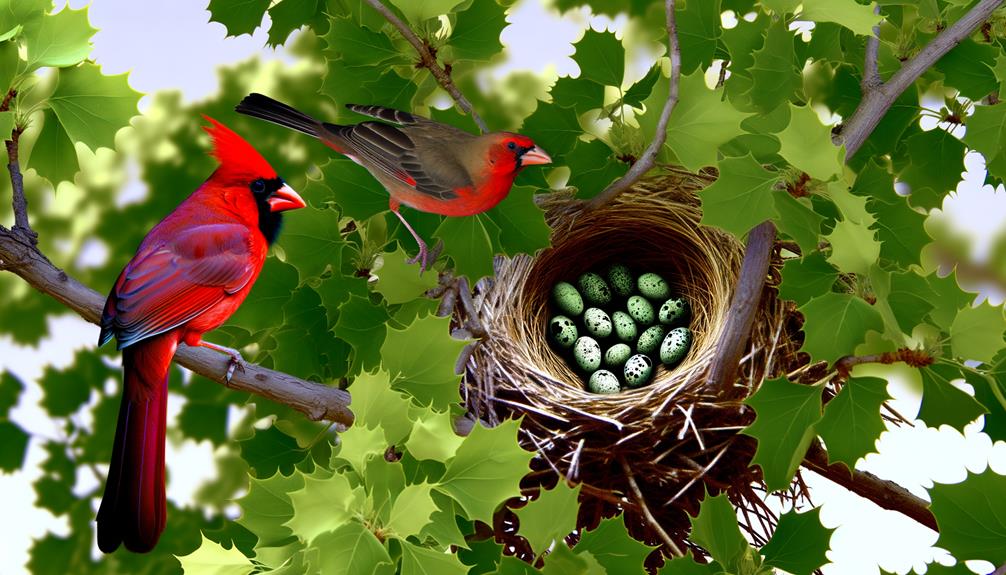
You'll find that cardinals prefer nesting in dense shrubs or low tree branches, which offer excellent concealment from predators.
During the egg incubation period, typically lasting 11 to 13 days, both male and female cardinals display heightened vigilance.
After hatching, their parental care behavior includes frequent feeding and protection of the nestlings until they fledge.
Nest Location Preferences
Cardinals typically select dense shrubs or small trees for their nesting sites, seeking locations that offer both concealment from predators and proximity to food sources. You'll often find their nests in thick tangles of vines, honeysuckle, or brambles, which provide excellent cover. They prefer heights between one and fifteen feet above ground, ensuring easy access and protection.
Research shows that cardinals favor sites near edges of wooded areas or gardens, optimizing their foraging efficiency. Their nests, crafted from twigs, bark strips, and grass, are meticulously concealed to deter predators like snakes and raccoons. The strategic choice of these locations underscores their instinct for survival and adaptability in various habitats, reflecting their need for both security and sustenance.
Egg Incubation Period
During the egg incubation period, cardinal females diligently maintain a consistent temperature by sitting on the nest for about 11 to 13 days until hatching occurs. You'll notice they exhibit remarkable patience and focus, important for embryonic development.
- Temperature Regulation: Females control nest temperature, typically around 37.5°C, ensuring ideal conditions.
- Minimal Disturbance: They limit movements, reducing the risk of attracting predators to the nest.
- Regular Turning: Eggs are turned several times daily to prevent the embryo from sticking to the shell.
- Nutritional Needs: Females take brief foraging breaks, relying on stored fat reserves to sustain them.
These behaviors are necessary for the successful incubation and survival of the cardinal chicks.
Parental Care Behavior
Observations reveal that cardinal parents exhibit remarkable diligence and coordination in nest defense and chick nourishment. You'll notice adult cardinals alternating feeding trips, guaranteeing their chicks receive a consistent diet of insects and seeds. They also efficiently remove fecal sacs to maintain nest hygiene. Vigilant by nature, cardinals aggressively deter potential predators, often engaging in aerial displays to ward off intruders.
| Behavior | Description | Impact |
|---|---|---|
| Feeding | Alternating trips with insects and seeds | Consistent chick nourishment |
| Hygiene Maintenance | Removing fecal sacs | Clean, disease-free environment |
| Predator Deterrence | Aggressive aerial displays | Enhanced nest security |
| Coordination | Synchronizing activities | Efficient parental care |
You see, cardinal parents' unwavering commitment to their offspring's wellbeing guarantees higher survival rates, which is essential in environments where threats, like cowbirds, persist.
How Cowbirds Choose Hosts
Cowbirds utilize a combination of visual cues and environmental factors to carefully select their host nests, ensuring ideal conditions for their offspring's survival.
You'll notice that cowbirds are highly strategic in this process, focusing on several key aspects:
- Nest Location: They prefer nests in open habitats where they can easily observe and access potential hosts.
- Host Species: Cowbirds often choose smaller birds, such as cardinals, whose nests are less defended.
- Timing: They target nests during the host's egg-laying period to synchronize their egg deposition.
- Nest Condition: Healthy, well-constructed nests are favored, indicating a strong likelihood of successful incubation.
This meticulous selection process underscores the cowbird's evolutionary adaptations, allowing them to maximize reproductive success while minimizing risks.
The Parasitic Strategy
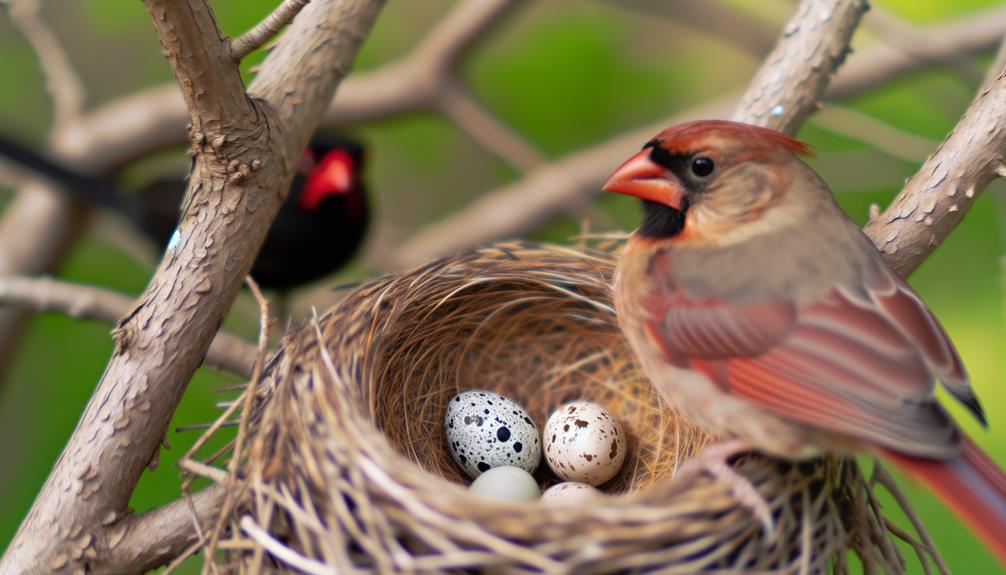
In their parasitic strategy, female cowbirds deftly lay their eggs in the nests of other bird species, ensuring their young benefit from the host's parental care without investing their own resources. They exhibit remarkable precision and timing, often laying eggs that closely resemble those of the host species, like cardinals. This mimicry minimizes the chance of egg rejection by the unsuspecting host.
Cowbirds synchronize their egg-laying with the host's breeding cycle, typically during the incubation period. You'll notice cowbirds targeting nests with eggs already present, leveraging the host's brooding instinct. This strategy allows cowbird chicks to hatch and grow, often outcompeting the host's offspring for food and care, thereby maximizing their survival and propagation.
Egg Removal Tactics
Female cowbirds employ strategic egg removal, deftly ejecting one or more of the host's eggs from the nest to increase the likelihood of their parasitic offspring receiving adequate resources. You'll find these tactics fascinating, rooted in evolutionary biology and fine-tuned for optimal efficiency.
Here's how cowbirds achieve this:
- Egg Selection: Cowbirds often target eggs that closely resemble their own to avoid detection.
- Physical Removal: Using their beaks, they lift and discard the host's eggs, often at a significant distance from the nest.
- Timing: This removal typically occurs just before or after the cowbird lays her egg, minimizing the host's chance to respond.
- Repeated Visits: Some cowbirds may return to verify the host hasn't replaced the removed eggs, optimizing their parasitic strategy.
Cardinal Defense Mechanisms
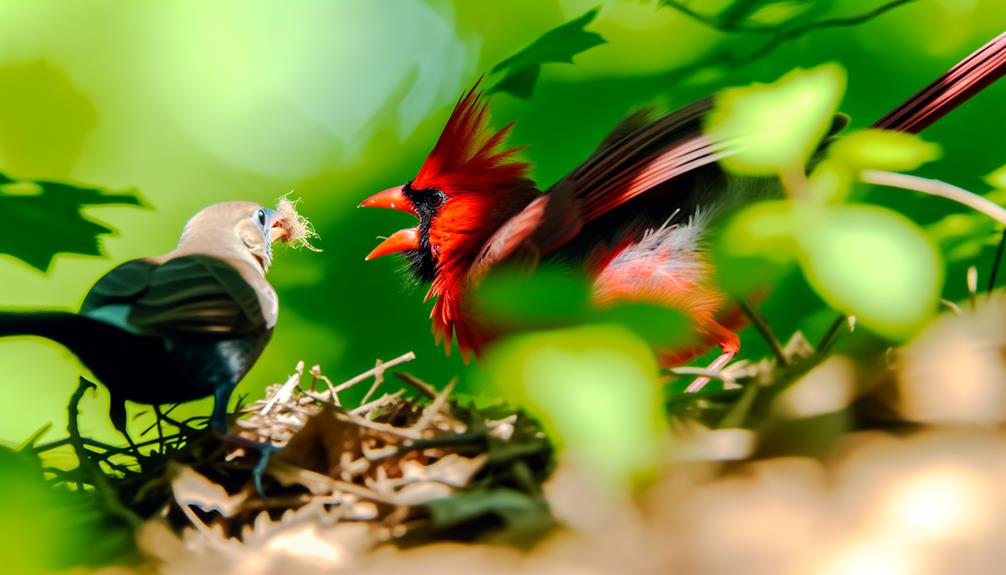
Despite the cowbirds' relentless tactics, cardinals have evolved a variety of defense mechanisms to protect their nests and guarantee the survival of their offspring.
You'll notice cardinals frequently engage in nest vigilance, where they guard their nesting sites with heightened alertness.
They also practice nest concealment, cleverly situating nests in dense foliage to reduce detection.
Cardinals utilize aggressive behaviors, such as mobbing, to deter intruders like cowbirds.
Scientific studies show that cardinals can recognize and remove cowbird eggs from their nests. This egg rejection behavior minimizes the parasitic impact.
By employing these strategies, cardinals effectively enhance their reproductive success.
Their adaptive responses exemplify a natural drive for freedom and survival, counteracting the parasitic pressures exerted by cowbirds.
Impact on Cardinal Offspring
You'll notice that cardinal offspring face markedly reduced survival rates due to cowbird parasitism. Studies show that cowbird chicks often outcompete cardinal chicks for food, leading to malnutrition and high mortality among the native brood.
Additionally, the presence of cowbird eggs disrupts the cardinals' parental care, causing them to expend resources on the parasitic invaders rather than their own young.
Reduced Survival Rates
Cowbird parasitism drastically reduces the survival rates of cardinal offspring by monopolizing parental care and resources, leading to starvation and neglect of the native chicks.
You'll find that:
- Competition for Food: Cowbird chicks often grow faster and demand more food, leaving cardinal chicks malnourished.
- Nestling Aggression: Cowbird nestlings may physically outcompete or harm cardinal chicks, reducing their chances of survival.
- Delayed Development: Cardinal chicks in parasitized nests display stunted growth and prolonged dependency periods.
- Increased Mortality: The combined stress factors result in higher mortality rates among cardinal offspring.
These observations underscore a significant issue: cowbird parasitism directly impacts the reproductive success and population stability of cardinals, making it a compelling area for conservation efforts.
Disrupted Parental Care
Parental care in cardinal nests disrupted by cowbirds results in misallocated energy and resources, severely undermining the growth and health of cardinal offspring. When cowbird eggs are laid in cardinal nests, the cardinal parents often can't distinguish them from their own. This leads to an increase in parental provisioning toward the cowbird chicks, which typically grow faster and demand more food.
The cardinal chicks, as a result, receive considerably less attention, which stunts their development. Studies show that the survival rate and fledging success of cardinal chicks drop noticeably in these parasitized nests.
You'll observe that this diversion of care compromises the cardinals' reproductive success, as their own offspring struggle to thrive amidst the presence of the intruding cowbirds.
Competition for Resources
In parasitized cardinal nests, the competition for resources intensifies as cowbird chicks, which grow rapidly and have a higher metabolic demand, monopolize the food provided by the cardinal parents. This dynamic negatively impacts the cardinal offspring.
Nutritional Deficiency: Cardinal chicks receive less food, leading to stunted growth and development.
Increased Mortality: Higher starvation rates among cardinal chicks due to insufficient nourishment.
Parental Stress: Cardinal parents expend more energy, straining to meet the demands of the cowbird chicks, reducing their care quality.
Behavioral Alterations: Cardinal chicks, in a desperate bid for survival, may exhibit increased aggression or altered begging behaviors.
These impacts underscore the detrimental effects of resource competition on cardinal offspring.
Behavioral Adaptations

Nest parasitism is a behavioral adaptation where cowbirds lay their eggs in cardinal nests, compelling host birds to expend resources raising the parasitic offspring, often to the detriment of their own young.
You'll observe that cowbird eggs hatch earlier, giving cowbird chicks a head start in growth and competition for food. This early hatching triggers an instinctive feeding response in the cardinal parents, who then prioritize the larger, more demanding cowbird chicks.
Studies show that cowbirds have evolved cryptic egg coloration and reduced egg size to minimize detection. Additionally, cowbirds exhibit egg mimicry and rapid development, further ensuring their survival.
These adaptations illustrate an evolutionary strategy aimed at maximizing reproductive success while imposing significant costs on their unsuspecting hosts.
Success Rates of Parasitism
Research indicates that cowbird parasitism success rates vary depending on host species' defensive behaviors and ecological conditions. You'll find that these rates are influenced by several factors:
- Host Vigilance: Species like the American Robin often recognize and eject cowbird eggs.
- Nest Concealment: Birds nesting in dense vegetation can evade cowbird detection, reducing parasitism.
- Temporal Factors: Early breeders sometimes escape parasitism as cowbirds lay eggs later in the season.
- Host Size: Larger hosts are better at defending their nests, lowering cowbird success.
Ecological Consequences

Cowbird parasitism dramatically alters avian community dynamics by disrupting host species' reproductive success and leading to long-term shifts in population structures.
You'll notice that when cowbirds lay eggs in cardinal nests, the resulting competition for resources often disadvantages the cardinal chicks. This parasitism can reduce the host's fledgling survival rates, causing a ripple effect through the local ecosystem.
Over time, the decreased reproductive success of host species like cardinals can lead to population declines, further altering the ecological balance. You'll find that affected bird communities may experience changes in species composition and diversity, creating an environment where cowbirds thrive at the expense of other avian species.
This shift impacts the entire food web, influencing predator-prey relationships and habitat dynamics.
Conservation and Management
Effective conservation and management strategies are essential for mitigating the impact of cowbird parasitism on cardinal populations and maintaining ecological balance. You'll need to focus on scientifically proven methods to achieve this goal.
Here's a list of effective strategies:
- Habitat Management: Enhance cardinal habitats by increasing vegetation density, which makes it harder for cowbirds to locate nests.
- Cowbird Trapping: Implement targeted trapping programs to reduce cowbird populations in critical areas.
- Nest Monitoring: Regularly monitor cardinal nests to identify and remove cowbird eggs, thereby protecting native species.
- Public Education: Educate the public on the importance of controlling cowbird populations and promote community involvement in conservation efforts.
Conclusion
You've now seen how cowbirds, those relentless avian infiltrators, brazenly hijack cardinals' nests with surgical precision.
These feathered fiends don't just sneak in; they commandeer. The cardinals' diligent efforts are mercilessly usurped, resulting in a dramatic ecological tug-of-war.
With their parasitic prowess, cowbirds have perfected an evolutionary art form, leaving cardinals scrambling to adapt.
So next time you see a serene cardinal nest, remember: it's a battleground in an avian arms race of epic proportions.






